We may not have the course you’re looking for. If you enquire or give us a call on +918037244591 and speak to our training experts, we may still be able to help with your training requirements.
Training Outcomes Within Your Budget!
We ensure quality, budget-alignment, and timely delivery by our expert instructors.
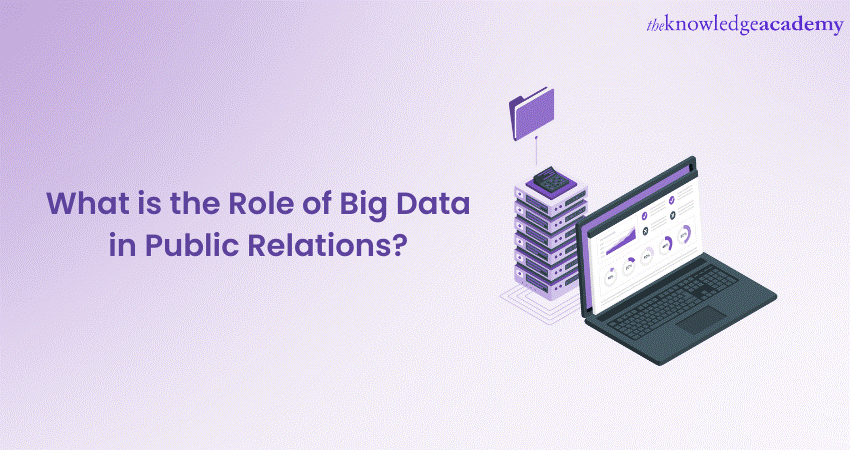
When it comes to Public Relations, staying ahead of the curve is crucial. Imagine harnessing vast amounts of information to craft more effective campaigns, predict public sentiment, and make data-driven decisions. This is the promise of Big Data in Public Relations. By analysing extensive datasets, PR professionals can uncover insights that were previously unimaginable, transforming the way they approach their work.
For those in the Public Relations field, the integration of Big Data offers a revolutionary opportunity. The ability to process and interpret large volumes of data allows for more precise targeting, better crisis management, and enhanced measurement of campaign success. So, how exactly does Big Data impact Public Relations? This blog delves into the transformative potential of Big Data in Public Relations, exploring its benefits, challenges, and future prospects.
Table of Contents
1) Definition and Scope of Big Data in Public Relations
2) Evolution of Big Data in Public Relations
3) How can Big Data be used in PR?
4) Benefits of Big Data in Public Relations
5) Future trends of Big Data in PR
6) Conclusion
Definition and Scope of Big Data in Public Relations
Public Relations involves managing and disseminating information from an individual or organisation to the public with the goal of influencing public perception and maintaining a positive image. PR professionals use strategic communication through channels like media and social platforms to achieve this.
Big Data in Public Relations encompasses the vast volumes of data generated from various digital interactions, including websites, social media, and other online platforms. It involves collecting, analysing, and leveraging this data to inform PR strategies, monitor public sentiment, and elevate communication efforts.
By utilising Big Data, Public Relations professionals can:
1) Gain deeper insights into audience behaviour
2) Personalise campaigns
3) Fostering stronger relationships with the public and stakeholders
What is the Relationship Between Big Data and Public Relations?
Big Data refers to the collection of both large and complex datasets generated over the internet. It is often characterised by the three Vs, which are as follows:
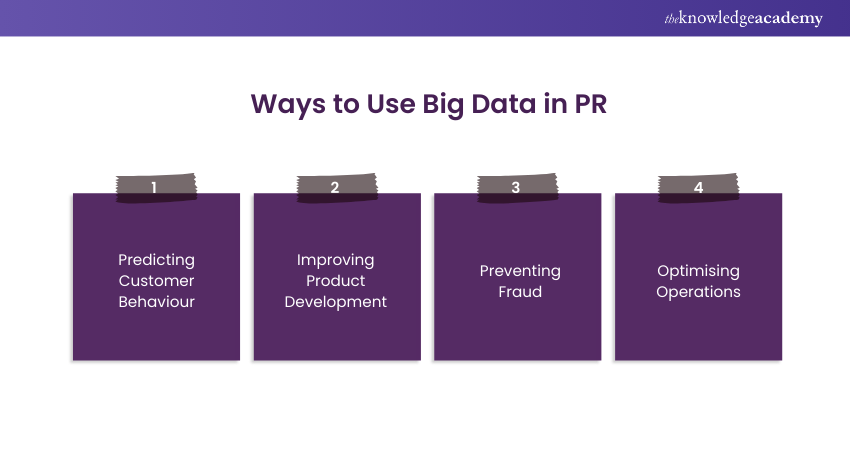
a) Volume: Volume means the massive amount of data that is being generated every day. This data comes from a variety of sources, such as social media, sensors, and transactional records.
b) Velocity: Big Data is also characterised by its Velocity, at which it is generated and processed. Velocity can make it difficult to store and analyse Big Data using traditional methods.
c) Variety: Big Data is very diverse, or varied, in its format. This can make it difficult to integrate and analyse data from different sources.
In Public Relations, the practitioners can use 3Vs of Big Data in the following ways:
a) Predicting Customer Behaviour: By analysing data on customer purchases, social media activity, and other factors, i.e., the Variety of Big Data, businesses can predict the choice of customers.
b) Improving Product Development: By analysing data on customer feedback, PR professionals can provide insights to their clients on improving their products to meet maximum customer satisfaction.
c) Preventing Fraud: By analysing data on financial transactions, businesses can identify and prevent fraudulent activity. This insight derived from Big Data helps PR professionals formulate strategies to help the companies avoid any kind of fraudulent activities.
d) Optimising Operations: Big Data helps PR professionals analyse data that reveal customer pain points. This further helps them give insights to the business on improving their operations that will maximise customer satisfaction. These insights on operations will not only improve customer experiences but will also help the business improve efficiency and productivity. For example: When a customer provides negative feedback about a company’s product in different social media channels or provides input on how to improve the check-out process, the PR professionals can take that feedback and advise the business to devise or adjust their business operations for the customers’ ease.
Learn more about Big Data and Analytics by registering for our Big Data and Analytics Training.
Evolution of Big Data in Public Relations
The evolution of Big Data in Public Relations can be traced back to the early 2000s when the first social media platforms began to emerge. PR professionals quickly realised that these platforms could be used to collect and analyse data about their target audiences and engage with them more effectively.
PR professionals used Social Media Analytics tools to track mentions of their brand or client, identify influencers, and measure the sentiment of conversations. This data could then be used to identify opportunities for PR outreach or to mitigate potential crises.
Over the past few years, the use of Big Data in Public Relations has evolved significantly. PR professionals are now using it to do more than just monitor and research. They are also using it to perform the following:
a) Target Their Communications More Effectively: By using Big Data to segment their audiences, PR professionals can ensure that their messages are reaching the right people.
b) Measure the Impact of Their Campaigns Precisely: By tracking several metrics, such as social media engagement, website traffic, and media coverage, PR professionals can get a more accurate picture of the impact of their campaigns.
c) Create More Engaging Content: By understanding what their audiences are interested in, PR professionals can create content which can be shared and engaged with.
d) Prevent Crises: By monitoring social media for negative sentiment, PR professionals can identify potential crises early on and take steps to mitigate them.
As the Volume and Variety of data continues to grow, the use of Big Data in Public Relations is likely to become even more important. PR professionals who are able to harness the power of Big Data will be well-positioned to succeed in this ever-changing field.
Master the next level of Analytics with our Advanced Data Analytics Certification Training - join today!
How can Big Data be Used in PR?
Big Data can be used in PR in a variety of ways, including the following:
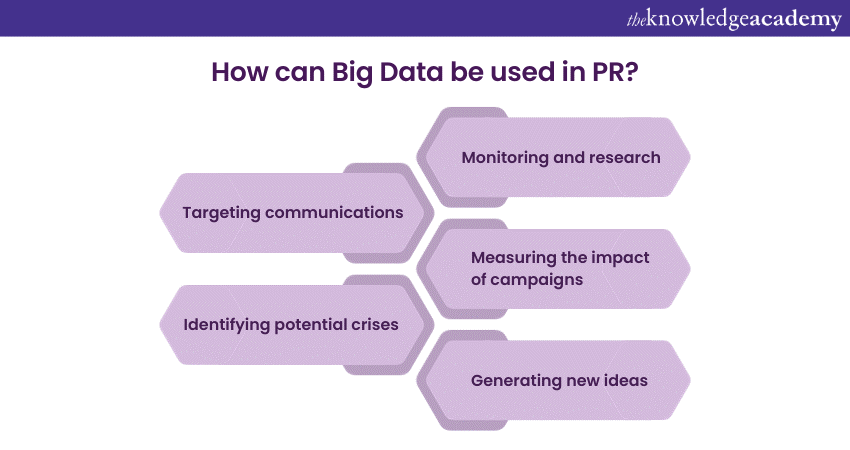
a) Monitoring and Research: Big Data can be used to monitor social media, news articles, and other sources for mentions of a brand or client. This data can be used to identify trends, influencers, and the impact of PR campaigns.
b) Targeting Communications: It can be used to target communications more effectively. For example, a company can use Big Data to identify customers who are interested in a new product and then target those customers with specific messages.
c) Measuring the Impact of Campaigns: It can be used to measure the impact of all the PR campaigns. For example, a company can use customer data to track the number of social media engagements, website visits, and media mentions generated by a PR campaign.
d) Identifying Potential Crises: It can be used to identify potential crisis early on. For example, a company could use Big Data to track mentions of its brand on social media for negative sentiment.
e) Generating New Ideas: Big Data can be used to generate new ideas for PR campaigns. For example, a company can use Big Data to identify trends in customer behaviour that could be used to create new marketing campaigns.
f) Improving Decision-making: Big Data can be used to improve decision-making by providing PR professionals with insights into their audiences and the competitive landscape.
g) Building Relationships: Big Data in Public Relations can be used to build relationships with stakeholders. For example, a company can use it to track the engagement of stakeholders with its social media content.
h) Partner with DataScientists and Other Experts: Big Data is a complex field, and no single PR professional can be an expert in everything. PR professionals should partner with Data Scientists and other experts to help them collect, analyse, and interpret data.
i) Use Data Visualisation Tools: Data Visualisation tools can help PR professionals make data more accessible and understandable to audiences. This can be helpful for communicating complex ideas or trends to stakeholders.
j) Use it to Build Relationships with Influencers: Influencers are people who have a large following on social media or on other online channels. PR professionals can use their data to amplify messages and reach a wider audience by collaborating with them. Big Data can be used to identify influencers who are relevant to a PR campaign and who are likely to be influential with the target audience.
k) Use it to Track the Effectiveness of Social Media Campaigns: Social media is a major for building Public Relations. It can be used to track the number of social media engagements, website visits, and media mentions generated by a social media campaign. This information is used to optimise campaigns and improve their effectiveness.
l) Use it to Identify and Mitigate Risks: Big Data is used to identify potential risks to a brand or organisation. For example, it can be used to track mentions of a brand on social media for negative sentiment. This information can be used to mitigate risks by taking steps to address the negative sentiment or by issuing a public statement.
Unlock your PR potential today with our Introduction to Public Relations Course - register today!
Benefits of Big Data in Public Relations
Here are some benefits that can be leveraged by utilising Big Data in Public Relations:
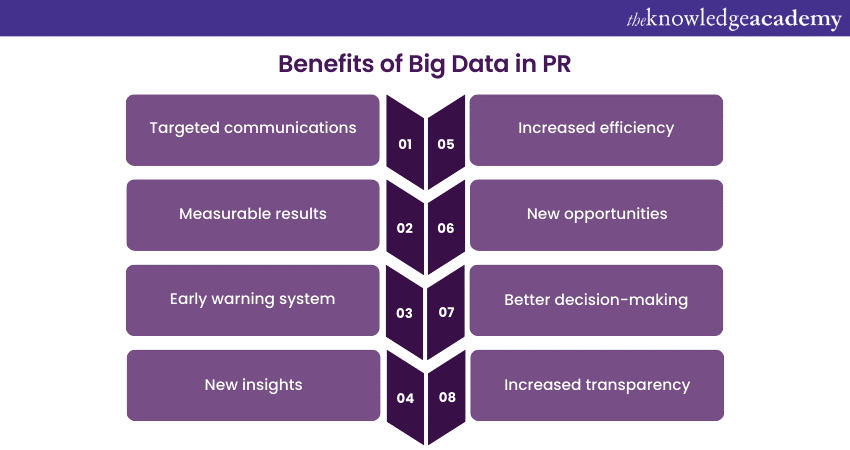
a) Early Warning System: Big Data can be used to monitor social media and other channels for negative sentiment, which can help PR professionals identify potential crises early on and take steps to mitigate them. For example, a company can use it to track mentions of its brand on social media and then identify any negative sentiment that could lead to a crisis.
b) New Insights: It can be used to identify trends and patterns in data, which can provide PR professionals with new insights into their audiences and their competitors. For example, a company can use it to track the search terms that people use to find information about its products and then use this information to create more effective and successful marketing campaigns.
c) Increased Efficiency: Big Data can be used to automate tasks such as media monitoring and research, which can free up PR professionals to focus on more strategic work.
d) New Opportunities: It can be used to create new opportunities for PR, such as developing new products and services or identifying new target audiences. For example, a company can use Big Data to identify new markets for its products or to develop new services that cater to the demands of specific audiences.
e) Better Decision-making: Big Data in Public Relations can provide insights into their audiences and the competitive landscape. This can help organisations make better decisions about their PR campaigns. For example, an organisation can use it to identify the most effective channels to reach its target audience or to determine the best time to launch a new product.
f) Increased Transparency: Big Data can be used to make PR campaigns more transparent, as PR professionals can share data with their clients and stakeholders to show them how their campaigns are performing. Therefore, it helps to build trust and credibility with stakeholders.
Dive into the world of Big Data Analysis with our Big Data Analysis Training - join today!
Future Trends of Big Data in PR
The use of Big Data in PR is still in its early stages, but it is rapidly evolving. As the Volume and Variety of data continue to grow, PR professionals will need to find new ways to use Big Data to their advantage. Here are some of the future trends of Big Data in PR:
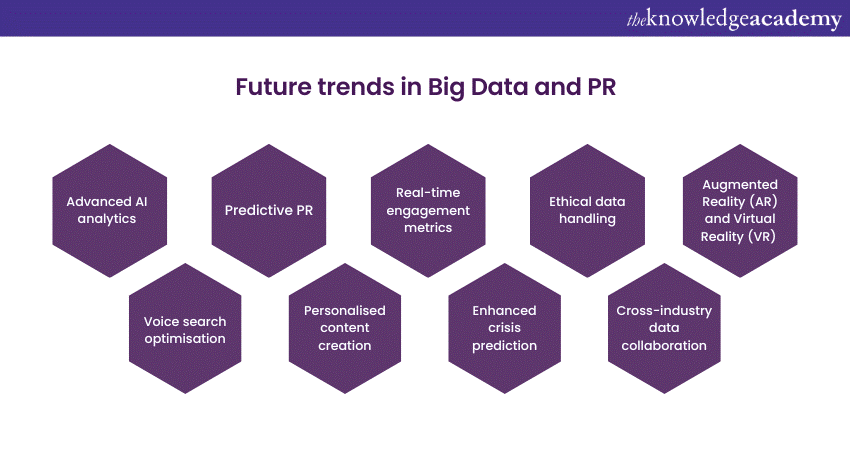
a) The Popularity of Artificial Intelligence (AI): AI is already being used in PR to automate tasks such as media monitoring and research. In the future, AI is likely to be used to do even more, such as generating creative content and responding to customer queries.
b) The Use of Predictive Analytics: Predictive Analytics is used to predict future pattern in user data. In PR, Predictive Analytics can be used to identify potential crises early on or to target communications more effectively.
c) The Growth of Data Generated from Social Media: Data from social media is a valuable source of information for PR professionals. In the future, PR professionals will need to collect, analyse, and interpret data generated from social media to stay ahead of the curve.
d) The Development of New Data Sources: As new technologies emerge; new data sources will become available to PR professionals. For example, wearable devices are generating a wealth of data about people's movements and activities. PR professionals can use this data to understand how people are interacting with their brands.
e) The Need for Data Literacy: As Big Data becomes more complex; PR professionals will need to be data-literate. This means being able to understand and interpret data, and to use it to make informed decisions.
f) The use of Real-time Analytics: Real-time analytics is the ability to analyse data as it is being generated. In PR, real-time analytics can be used to monitor social media and other channels for breaking news or trends. This information will then be used to respond quickly and effectively to any potential crises or opportunities.
g) The Use of Data Visualisation: Data Visualisation is the use of charts, graphs, and other visual representations to communicate data. In PR, Data Visualisation is used to make data more accessible and understandable to audiences. This can be helpful for communicating complex ideas or trends to stakeholders.
h) Using Big Data Ethically: As Big Data becomes more powerful; it is important to use it ethically. PR professionals need to be aware of the potential risks of using it, such as privacy concerns and bias. They need to develop ethical guidelines for the use of Big Data in PR and ensure that these guidelines are followed.
i) The Use of Big Data for Social Good: Big Data can be used to address social problems, such as poverty, hunger, and climate change. PR professionals can use Big Data to raise awareness of these problems, develop solutions, and hold organisations accountable.
Conclusion
We hope you have read this blog and gained a clear understanding of Big Data in Public Relations. Big Data provides valuable insights, elevates strategy development, and enables real-time decision-making. It allows PR professionals to understand audience behaviour, predict trends, and personalise communication efforts. By leveraging Big Data, Public Relations can transform from a reactive discipline to a proactive, data-driven powerhouse, ensuring more effective and impactful campaigns.
Unify Big Data and Data Science skills with our Big Data Analytics & Data Science Integration Course.
Frequently Asked Questions

Marketers and media relations professionals can gain valuable insights from PR statistics. These data provide a clearer understanding of industry trends, that helps enable better anticipation of potential challenges that could impact PR initiatives.

Data Analytics in public relations involves collecting, analysing, and interpreting data to measure the effectiveness of PR campaigns. By leveraging Data Analytics, PR professionals can track media coverage, measure engagement, assess sentiment, optimise strategies and demonstrate ROI.

The Knowledge Academy takes global learning to new heights, offering over 30,000 online courses across 490+ locations in 220 countries. This expansive reach ensures accessibility and convenience for learners worldwide.
Alongside our diverse Online Course Catalogue, encompassing 17 major categories, we go the extra mile by providing a plethora of free educational Online Resources like News updates, Blogs, videos, webinars, and interview questions. Tailoring learning experiences further, professionals can maximise value with customisable Course Bundles of TKA.

The Knowledge Academy’s Knowledge Pass, a prepaid voucher, adds another layer of flexibility, allowing course bookings over a 12-month period. Join us on a journey where education knows no bounds.

The Knowledge Academy offers various Big Data and Analytics Courses, including the Big Data Architecture Course and Data Science Analytics Course. These courses cater to different skill levels, providing comprehensive insights into Data Pipeline Architecture.
Our Data, Analytics & AI Blogs cover a range of topics related to Big Data, offering valuable resources, best practices, and industry insights. Whether you are a beginner or looking to advance your Data Analytics skills, The Knowledge Academy's diverse courses and informative blogs have got you covered.
Upcoming Digital Marketing Resources Batches & Dates
Date
 Hadoop Big Data Certification
Hadoop Big Data Certification
Thu 23rd Jan 2025
Thu 20th Mar 2025
Thu 22nd May 2025
Thu 17th Jul 2025
Thu 18th Sep 2025
Thu 20th Nov 2025







 Top Rated Course
Top Rated Course



 If you wish to make any changes to your course, please
If you wish to make any changes to your course, please


